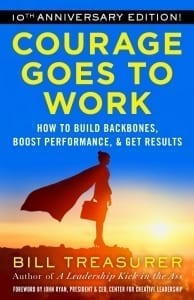5 Telltale Signs of Fear-Based Leadership

Consider these facts:
- According to Human Resource Executive magazine, roughly one-third of U.S. workers spend at least 20 hours at work every month complaining about their bosses, instead of performing their jobs.
- Gallup reports that American workers who are unhappy with their bosses are significantly less productive, to the tune of $360 billion in lost productivity each year.
- A study published in the Journal of Managerial Psychology found that people who are mistreated on the job are twice as likely to be depressed at work and 33 percent more likely to report exhaustion and sleep disorders, which all disrupt productivity.
Given how damaging fear can be—and given the financial consequences—how can you assess if your organization is operating under fear’s grip? Look for these five telltale signs:
CYA Rules the Day. If employees spend an inordinate amount of time generating proof that they’re doing their jobs, they’re fearful—and worried about saving their tails. This may take the form of long lists of people cc’d on mundane email exchanges, obsessive meeting summaries, and employees who request formal approvals for everyday tasks.
Leaders Are Oblivious. When leaders are insulated from employee feedback, they become dangerously blind to themselves. Typically, the higher up you go in the organizational food chain, the less performance feedback is given. In most organizations, feedback flows downward, keeping leaders dangerously and blithely oblivious.
Bean Counters Call the Shots. In fear-based cultures, the educational backgrounds of C-suite leaders can disproportionately favor finance and accounting, which causes organizations to be hyper-analytical and risk-averse. When financial acumen is valued more than creativity or innovation, decisions end up being driven solely by the numbers, or by the fear of not meeting those numbers, instead of what’s in the best interest of the organization.
Everything Is Needed Yesterday. When fear-based leadership reigns, work environments turn toxic, permeated by anxiety and urgency. In such places, regardless of their roles, everyone seems to have the same job: firefighter! By jumping from one blazing inferno to the next, workers lose focus and their performance suffers.
People Are Crucified for Mistakes. When leaders rule through fear, even smart mistakes are punished swiftly and harshly, creating a play-it-safe-at-all-costs environment. Workers end up hiding their mistakes or blaming others for them. They cry, “Who caused this to happen?” instead of “How did this happen?”
Fortunately, despite all of its badness, fear does have one redeeming quality: it’s an invitation to courage. As such, fear, or more precisely, the courage that fear often prompts, can help you encounter your better self. By setting the tone from the top, you’ll set the stage for courage to prevail.
About the Author














Leave a Reply
Want to join the discussion?Feel free to contribute!